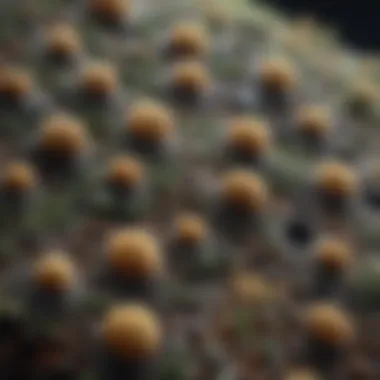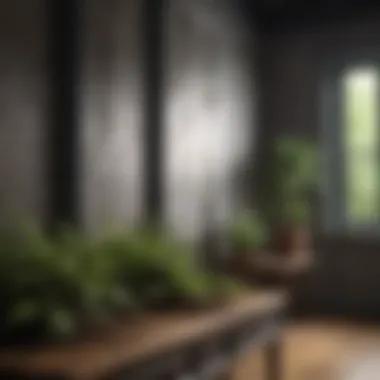Understanding the Unique Aroma of Mold


Intro
The aroma of mold is often dismissed or unnoticed until it becomes a pressing issue. Homeowners and enthusiasts must grasp the significant complexities behind mold odors. Understanding these odors requires exploring the biochemical properties of various mold types and considering the environmental factors that promote their growth. The implications for indoor air quality and overall health can be pronounced, often leading to serious health risks.
This article aims to comprehensively analyze the distinctive aroma of mold, helping readers identify and address mold-related concerns in their living spaces. As we unpack the intricate relationships between mold types, odors, and health implications, we will provide practical strategies for detection and remediation. This synthesis of information serves not just as a guide, but as an essential resource for anyone looking to maintain a healthy indoor environment.
Intro to Mold and Its Significance
Mold is ubiquitous in our environment, appearing in diverse forms. Understanding mold and its distinctive aroma is critical not only for homeowners but for anyone interested in maintaining a healthy indoor air quality. Mold can thrive in damp conditions and can be found in both residential and commercial spaces. Its impact goes beyond mere aesthetics. Mold has implications for health, safety, and building integrity, making it essential to comprehend its characteristics and behaviors.
In this section, we will dive into the definition of mold and its roles within ecosystems before exploring the implications of its odors within indoor environments. Recognizing the significance of mold is the first step toward managing its presence effectively.
Defining Mold
Mold refers to a diverse group of fungi that reproduce by forming spores. These microscopic spores can easily float through the air and settle on different surfaces. When conditions are favorable—such as humidity and organic material—these spores can germinate and develop into visible colonies, commonly recognized as mold. The appearance of mold can range from fuzzy patches to slimy spots, differing in color from green and black to white or even bright shades. These characteristics make mold easily identifiable in many cases.
The specific types of mold vary greatly, with thousands identified worldwide. Some molds are more benign, while others produce mycotoxins that can pose serious health risks. Understanding the specifics of these fungi is key to identifying potential hazards within indoor environments.
The Role of Mold in Ecosystems
Mold plays a vital role in natural ecosystems. It contributes to the decomposition of organic matter, assisting in nutrient cycling, and enriching soils. This process is essential, as it allows the nutrients locked within dead plants and animals to be reutilized by living organisms. The breakdown of this matter is a necessary process for ecological balance.
Molds also form symbiotic relationships with various plants, enhancing their nutrient uptake. These interactions illustrate how molds are not merely nuisances but integral components of ecosystems.
In the context of indoor environments, the perception of mold shifts. While it is beneficial outside, in enclosed spaces, mold can lead to health concerns for individuals exposed. Addressing these indoor issues requires understanding mold's complexities beyond its ecological functions.
"Mold is a dual-edged sword: vital in nature yet problematic indoors."
By becoming aware of mold's ecological significance and recognizing the implications of its odor, homeowners can better manage their indoor environments. This understanding molds the foundation for the following sections, where we will explore the chemical composition of mold and its distinct aroma.
Chemical Composition of Mold
Understanding the chemical composition of mold is critical in dissecting its distinctive aroma. The interaction of various biological and environmental factors culminates in the release of specific odors associated with mold. Particularly significant are mycotoxins and volatile organic compounds (VOCs), which not only contribute to the identifiable smells but also have ramifications on health and environment. By exploring these elements, one can gain insight into mold's behavior and the potential impact on indoor air quality.
Understanding Mycotoxins
Mycotoxins are toxic compounds produced by certain molds during their growth phase. These toxins serve multiple functions for the mold, including protecting them from competing microorganisms. Notably, common molds like Aspergillus and Penicillium are known to produce mycotoxins. The presence of these compounds can correlate to certain odors experienced in affected areas. Understanding mycotoxins is important. They can pose serious health risks to humans; exposure has been linked to respiratory issues and other health problems. Effective detection is key to any remediation process.
- The following are common types of mycotoxins that can be emitted by mold:
- Aflatoxins
- Ochratoxins
- Trichothecenes
Consequently, awareness of mycotoxins helps in assessing not just the presence of mold, but also its potential hazards in living environments.
Volatile Organic Compounds and Their Role
Volatile organic compounds are another key aspect of mold's chemical makeup. These compounds easily vaporize at room temperature. Many molds emit VOCs that contribute to their distinct odors. The scent ranges from earthy and musty to more pungent chemical notes, ultimately affecting the indoor atmosphere. VOCs also reflect the health of a space; high concentrations can indicate a mold problem, and they are often linked to adverse health effects.
Some common VOCs produced by mold include:
- Geosmin, which has an earthy smell
- 2-Butanone, contributing to a sweeter scent
- Various alcohols and acids, leading to sharper, more irritating odors


In summary, understanding the role of VOCs in mold’s chemical composition amplifies awareness about surface contamination and potential health risks. Awareness regarding these compounds creates an informed approach to mold detection and subsequent remediation measures.
Identifying Mold Through Its Odor
Identifying mold through its odor is critical for maintaining a safe indoor environment. The distinctive smells associated with mold can act as a warning sign, indicating potential growth in areas that may not be visually accessible. This significance lies not only in the immediate detection of mold but also in the health risks it poses to occupants. Recognizing these odors allows homeowners and enthusiasts to act swiftly, ensuring adequate remediation before health implications develop.
Common Odors Associated with Mold
Earthy Smells
Earthy smells are often linked to various types of mold. These odors can resemble the scent of damp soil or decaying wood. The presence of earthy smells typically indicates the growth of mold in hidden spaces, where moisture accumulation may occur. This specific aspect is essential for mold identification, as it often alerts individuals to previously unnoticed issues.
The key characteristic of earthy smells is their dampness. This quality can make them a significant indicator of mold presence. However, while earthy odors can be effective for detection, they may not be as unmistakable as stronger mold scents. They fit well into this article as they can prompt an investigation for a more thorough mold assessment.
The unique feature of earthy smells is that they can vary slightly depending on the specific mold species. This variability can complicate identification. On the other hand, it can serve as a light guide for determining the mold's environment. Knowing this characteristic can help homeowners understand the extent of moisture issues they may have.
Musty Scents
Musty scents are possibly the most recognized odor associated with mold. Often described as stale or wet, these odors can indicate a more advanced mold problem. Recognizing a musty smell is useful for both homeowners and professionals in their assessment of air quality.
Musty scents serve as a strong, recognizable cue for the presence of mold. This characteristic makes them a fundamental element in indoor air quality discussions. These scents are highly relevant for this article, as they significantly contribute to ongoing awareness and recognition of mold issues.
A unique feature of musty scents is their ability to linger in an environment. They can stick around long after mold has been removed if not adequately remediated. This property can be a disadvantage, leading to ongoing frustration for those managing mold issues. Identifying the musty smell correctly can allow prompt remediation, potentially minimizing further damage.
Other Chemical Notes
Mold can emit various other chemical notes that are not always classified under the commonly identified smells. These include a range of scents that may seem more acrid or pungent. They often indicate specialized types of mold that may be producing mycotoxins. Identifying these odors is crucial for assessing the dangerous levels of mold present in an environment.
The key characteristic of other chemical notes is their harshness. This quality can be alarming, prompting immediate attention. They serve as a beneficial point of focus in the article as they can signify more severe mold problems.
Unique features of these chemical notes are their potential to cause health issues even before visible mold growth occurs. They might indicate latent mold activity that can adversely affect indoor air quality. Understanding these odors adds complexity to mold identification and emphasizes the importance of vigilance in mold management.
Variability of Mold Odors by Type
Odors produced by mold can vary widely depending on the species and environmental conditions. Different molds produce different volatile organic compounds, leading to a unique profile of smells. This variability can complicate detection but also provides insight into the specific mold present. Factors such as humidity, temperature, and surface type can influence these odors. Homeowners should be aware of this variability, as it can impact their approach to identification and remediation.
Environmental Factors Influencing Mold Smell
Understanding the environmental factors influencing mold smell is crucial for anyone wanting to manage mold growth in indoor spaces. The aroma that mold emits is not just unpleasant; it often signals underlying issues with humidity, temperature, and overall air quality. Recognizing these factors can help in formulating appropriate strategies to mitigate mold’s growth and its associated odors.
Humidity and Moisture Levels
Humidity is a primary factor affecting mold proliferation and smell. Mold thrives in damp environments, where moisture levels exceed 60%. When this occurs, the release of volatile organic compounds amplifies, resulting in the characteristic musty odors often detected indoors.
- Maintaining Proper Humidity: Homeowners should aim to maintain indoor humidity levels between 30% and 50%. This can be achieved through various means, such as using dehumidifiers, ensuring proper drainage around the home, and regularly checking for leaks.
- Impact on Odor Emission: High moisture not only facilitates mold growth but also enhances the intensity of its smell. As the moisture increases, so does the rate of mycotoxin release, which contributes further to unpleasant indoor air quality.
"Humid conditions are a breeding ground for mold, significantly impacting household air quality and health."
It is advisable to monitor humidity with a hygrometer, as understanding these levels is vital in preventing mold-related issues. Implementing good ventilation practices can aid in controlling humidity levels as well.
Temperature Impact
Temperature plays a significant role in mold growth and its distinctive smell. Mold species tend to favor warmer temperatures, typically thriving in ranges of 77°F to 86°F (25°C to 30°C).


- Optimal Growth Conditions: Within this temperature range, mold spores germinate more rapidly, and their metabolic processes are heightened, leading to increased odor production.
- Seasonal Variations: Understanding seasonal changes in temperature can be beneficial for preventing mold growth. For instance, during warmer months, it is essential to monitor areas like attics and basements that may not receive adequate airflow.
- Cooling and Heating Considerations: Using air conditioning can help lower both temperature and humidity, creating less favorable conditions for mold. Heating during winter months can also be regulated, ensuring spaces do not become excessively warm and humid.
Health Implications of Mold Exposure
The presence of mold in indoor environments poses significant health risks. Understanding these implications is crucial for homeowners and individuals who spend considerable time indoors. Mold spores can enter the lungs and contribute to various health issues, some of which may become serious if left unaddressed. This section aims to shed light on two critical health concerns associated with mold exposure: respiratory issues and allergic reactions.
Respiratory Issues Related to Mold
Mold is a well-documented trigger for a variety of respiratory problems. When mold spores are inhaled, they can cause immediate effects in sensitive individuals. Common respiratory complaints include:
- Coughing: A common reaction to airborne mold spores, this symptom may persist if mold exposure continues.
- Wheezing: This typically indicates constriction of the airways, leading to difficulty in breathing.
- Shortness of Breath: Individuals with existing respiratory conditions, like asthma, may experience exacerbated symptoms.
In some cases, mold exposure can lead to the development of chronic respiratory issues. For example, prolonged exposure may result in mold-induced asthma, where individuals become sensitive to the allergens produced by mold. It is essential to monitor indoor air quality and address mold promptly to mitigate these health effects.
Allergic Reactions Associated with Mold
Allergic reactions to mold are another serious health concern. Some individuals demonstrate hypersensitivity to mold spores. This hypersensitivity can result in:
- Sneezing and Nasal Congestion: Typical early signs of mold allergy manifest similarly to seasonal allergies.
- Skin Rashes: Direct contact with mold spores can lead to skin irritation or eczema.
- Eye Irritation: Symptoms such as redness, itchiness, and tearing are not uncommon.
In more severe cases, mold exposure may trigger anaphylaxis, a life-threatening allergic reaction. Individuals with a history of allergies should remain vigilant about mold exposure, as it can significantly impact their quality of life.
Mold is not just an aesthetic concern; it is a health hazard that deserves attention.
Taking these health implications into account, it's essential for homeowners to implement regular mold inspections and, if necessary, engage in remediation efforts to safeguard their indoor environments.
The Importance of Mold Detection
Mold detection plays a crucial role in maintaining both the integrity of structures and the health of individuals. Unearthed often in damp environments, mold presents risks that extend far beyond mere aesthetics. Understanding how to effectively detect mold is essential for homeowners, interior design enthusiasts, and anybody concerned with indoor air quality. The distinction between minor mold traces and more significant infestations can be life-altering. Timely detection can prevent extensive damage and negative health impacts.
Visual Inspection Techniques
Visual inspections are the first line of defense against mold. Look for visible signs in areas prone to moisture accumulation, such as bathrooms, kitchens, and basements. Pay particular attention to corners, behind appliances, and under sinks. The presence of water stains, discoloration, or an unusual texture on walls and ceilings can be clear indicators of mold growth.
When conducting a visual inspection:
- Use Good Lighting: Bright lights help identify subtle changes in material or color.
- Check for Cracks and Leaks: Inspect plumbing fixtures and surrounding areas for potential leaks that may not be immediately visible.
- Be Aware of Surface Changes: Elevated or raised surfaces May signal hidden mold growth, requiring more thorough examination.
Documenting these observations can also assist in any future remediation efforts.
Odor-based Detection Methods
Mold often announces its presence with a distinct, unpleasant odor. Understanding this smell can guide individuals to the source of potential infestations. Typically earthy or musty, these scents can vary based on specific mold types. As such, recognizing these odors early can be beneficial, allowing targeted inspection and remediation.
To utilize odor-based detection:
- Identify Sources: When a musty smell is detected, trace the odor to its potential source. This usually involves checking areas with high humidity or visible moisture.
- Understand Variability: Different mold species can produce different scents. For example, Aspergillus often emits a stronger odor compared to Penicillium. Understanding these nuances can enhance detection accuracy.
- Use Tools If Necessary: Personal protective equipment, like masks, should be worn while searching in mold-prone areas.
"The sooner you detect mold, the quicker you can address potential health risks and structural damages."
Strategies for Mold Remediation
Addressing mold in residential spaces is essential for maintaining both health and well-being. Mold remediation refers to methods and practices used to control and eliminate unwanted mold growth. Mold can pose health risks, especially to those with allergies or respiratory issues, and can damage property if left unchecked. Thus, understanding effective strategies for remediation becomes crucial for homeowners.


Professional Mold Removal Services
Engaging professionals for mold removal is a decision that many homeowners find necessary. Professional mold removal services provide a level of expertise that is often hard to match. They possess advanced equipment and knowledge about various mold types. These services typically include comprehensive inspections, removal, and post-remediation testing to ensure that the mold has been effectively eliminated.
Considerations when hiring a professional service include:
- Certifications and Experience: Choose a company that demonstrates proficiency. Certifications can signify a commitment to best practices.
- Thoroughness: Ensure that they perform complete assessments, not just superficial checks.
- Customer Reviews: Look for feedback from past clients. Positive reviews can give insights into the quality of service.
- Follow-up Services: Good services often include follow-up evaluations to monitor mold spore levels and ensure proper remediation.
In many cases, professionals can identify hidden mold that may not be immediately visible, addressing potential health risks before they grow worse. Their comprehensive approach may save homeowners time, effort, and potential future costs.
DIY Remediation Techniques
For those who choose to tackle mold issues themselves, several DIY techniques can be effective, provided safety is prioritized. These methods can be cost-effective and empower homeowners, but they require careful attention to detail to ensure safety and efficacy.
Key DIY techniques include:
- Identify the Source of Moisture: Find and fix leaks or water issues first. Mold thrives in damp conditions, so addressing the source is critical for long-term success.
- Cleaning Solutions: Use a mixture of water and vinegar or hydrogen peroxide for cleaning small areas of mold. Understanding how to properly mix and apply these solutions preserves surfaces while eliminating mold spores.
- Personal Protective Equipment (PPE): Wear gloves and masks to protect against exposure when handling mold. This precaution is vital, as mold spores can trigger allergies and other health problems.
- Ventilation and Airflow: Increase ventilation in mold-prone areas. Exhaust fans and dehumidifiers can play a role in reducing humidity.
- Seal Affected Areas: After cleaning, sealing affected areas can help prevent future mold growth. Paints and sealants designed to inhibit mold can be useful in this strategy.
"Mold remediation is a task that, whether professional or DIY, demands vigilance and thoroughness to ensure the health impacts are minimized."
Prevention of Mold Growth in Interiors
Preventing mold growth in interiors is crucial for maintaining a healthy and safe living environment. Mold can develop rapidly in damp and humid conditions, which can lead to a range of health issues. Understanding how to prevent it can save considerable time and expense associated with mold remediation. Moreover, proactive measures contribute significantly to indoor air quality and overall comfort in the home. Therefore, focusing on mold prevention strategies is essential.
Maintaining Indoor Humidity Levels
Indoor humidity plays a pivotal role in mold growth. Keeping humidity levels between 30% and 50% is ideal for discouraging mold proliferation. Here are several strategies to maintain proper humidity levels:
- Use Dehumidifiers: These appliances help remove excess moisture from the air, particularly in bathrooms, kitchens, and basements where humidity tends to be higher.
- Monitor Humidity Levels: Invest in a hygrometer to regularly check your indoor humidity. This can help you take appropriate action when levels rise.
- Fix Leaks Promptly: Any leaks in pipes or roofs should be repaired quickly. Moisture accumulation from leaks creates ideal conditions for mold.
- Limit Steam and Moisture: Use exhaust fans during and after showers or cooking to vent steam outside.
By implementing these practices, homeowners can significantly reduce the likelihood of mold growth.
Effective Ventilation Practices
Good ventilation is another cornerstone in the prevention of mold indoors. Adequate air circulation helps disperse moisture and reduce stagnant air, which mold thrives on. Consider the following practices for better ventilation:
- Open Windows: Whenever possible, open doors and windows to create airflow. Fresh air circulation is vital for dispersing moisture.
- Use Ventilation Fans: Install fans in bathrooms and kitchens to direct humid air outside, especially when performing activities that generate moisture.
- Ensure Attic Ventilation: Properly ventilate attics to prevent moisture buildup in these areas, as it can lead to severe mold growth over time.
- Create Cross-Ventilation: Arrange furniture and room layouts to promote airflow. Avoid blocking vents and ensure air can flow freely.
By paying attention to ventilation, homeowners not only combat mold but also contribute to a fresher indoor atmosphere.
Maintaining low humidity and effective ventilation are essential steps in mold prevention.
Closure
In the discourse surrounding mold, recognizing its aromatic profile is crucial. The distinctive aroma of mold serves as more than just a sensory warning; it indicates underlying biological processes and environmental conditions that merit attention. Understanding the impact of mold—both in terms of health and structural integrity—is essential for homeowners and enthusiasts alike. Not only can early detection prevent larger issues, but it can also ensure a safer indoor atmosphere.
Recap of Mold's Impact and Management
Mold's presence can have multifaceted consequences. Firstly, it can contribute to significant health problems. Prolonged exposure to mold spores can lead to respiratory issues, allergic reactions, and other health complications. Secondly, the structural stability of a home can be compromised due to moisture retention caused by mold growth. Regular inspections, combined with odor detection, are effective strategies for management.
In cases of mold discovery, either professional remediation or DIY methods can be employed to eliminate the problem. Homeowners must prioritize creating a dry and well-ventilated environment to prevent recurrence. Awareness of how mold influences both health and property management is crucial for effective mold control.
Final Remarks on Indoor Air Quality
Indoor air quality is significantly influenced by the presence of mold. Poor air quality can lead to discomfort and various health issues. It is imperative for homeowners to recognize indicators of mold, especially its distinctive scent, to maintain a healthy living environment.
Preventive measures such as dehumidification, adequate ventilation, and routine maintenance can improve overall air quality. Additionally, understanding mold types and their specific odors can aid in swift identification, preventing extensive damage and potential health risks.
The overall aim is to cultivate a space that is not only aesthetically pleasing but also promotes well-being and health. As mold awareness continues to evolve, homeowners arebetter equipped to manage the issue proactively.















